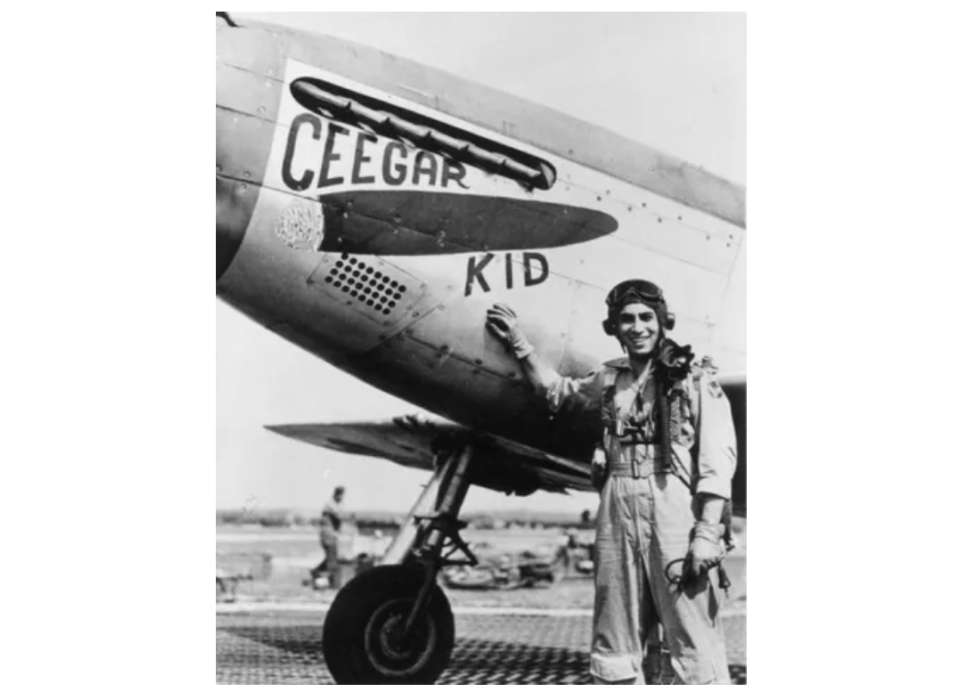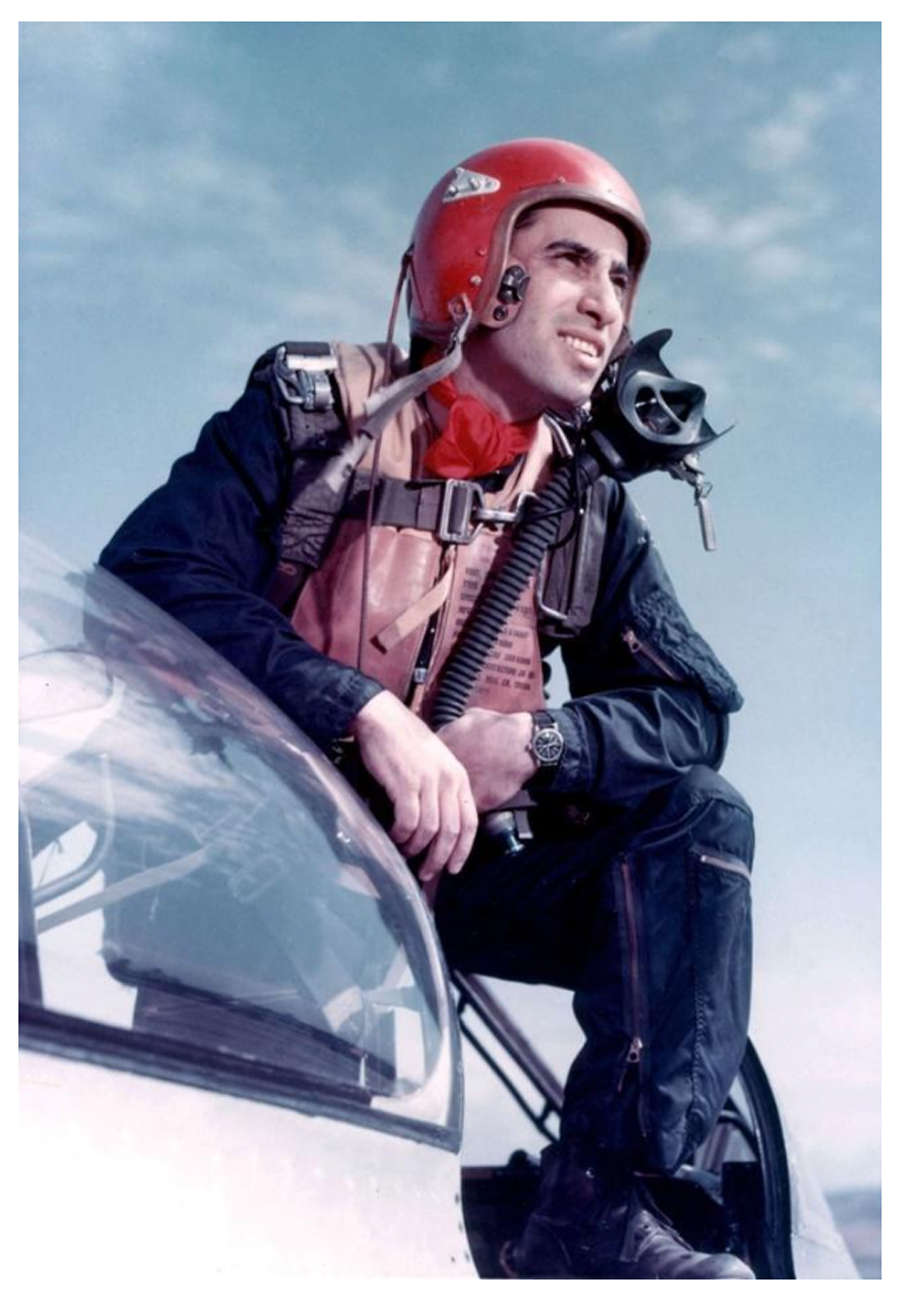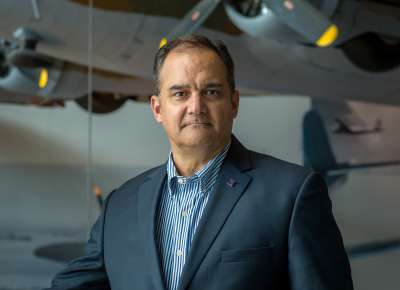Top image: Lt. James Jabara standing next to his P-51 bearing his nickname, “Ceegar Kid.” His penchant for cigars earned him the name. (American Air Museum UK Photo)
At only five feet five inches tall and wearing glasses, James Jabara did not look like your typical fighter pilot. A first-generation American of Lebanese descent, his parents emigrated to the United States from the town of Marjayoun, located just north of the modern-day border with Israel. They first settled in Muskogee, Oklahoma, where he was born October 10, 1923. The family relocated to Wichita, Kansas, when he was nine years old and opened a grocery store. Working for his parents, the industrious and swarthy Jabara attended Wichita North High School, where he earned the rank of Eagle Scout. When World War II broke out, Jabara wasted no time and enlisted in the Army at Fort Riley, Kansas, just down the road from his hometown. Intent on being a pilot, and despite his imperfect vision, he successfully earned both wings and selection as a fighter pilot—usually the toughest assignment to get.
Flying the famous P-51 Mustang for two tours in the European theater of operations (ETO), his first assignment was with the 363rd Fighter Group, Ninth Air Force. This first tour lasted from January to October 1944. In this capacity, Jabara was largely in direct support of Allied ground forces as they assaulted the beaches of Normandy and swung east toward greater Germany. During this period, he claimed a Messerschmitt Bf 109 aircraft after another enemy fighter had shot away his canopy. Luckily, he also survived two mid-air collisions, one with a fellow airman and one with the enemy. Reportedly, after his mid-air collision with the Luftwaffe pilot, they met on the ground, shook hands, and then walked away.
He returned to the United States after this tour but was soon reassigned to the ETO as a member of the 355th Fighter Groups, Eighth Air Force. During the war, Jabara flew 108 combat missions, clamed 1.5 aerial and 4 ground kills, and was awarded the Distinguished Flying Cross with one Oak Leaf Cluster, and the Air Medal with 18 Oak Leaf Clusters. It was also during this time that he received his nom de guerre, “the Ceegar Kid,” due to his penchant for smoking stogies. Unlike many men in the services after V-E and V-J Day, Jabara remained on active duty and transitioned into the newly created US Air Force.
From 1947 to 1949, he was assigned to the Tactical Air School at Tyndall Air Force Base, as well as the 53rd Fighter Group in Okinawa, and learned to fly America’s first operational jet fighter, the P-80 Shooting Star. Describing his first flight in the jet, Jabara said: “It was entirely different. I was at 10,000 ft before I remembered to raise my landing gear. . . . It was so quiet, so fast . . . I guess that was the happiest moment in my life.” Eventually, he transitioned to fly the sleek, new F-86 Saber jet and was assigned to the 4th Fighter Intercept Wing (FIW). With the outbreak of the Korean War in July 1950, the Wing’s F-86s were placed aboard an aircraft carrier and sent to the western Pacific. Initially flying out of Japan, the unit moved to Kimpo Airfield in Korea with Jabara assigned to the 334th Fighter Interceptor Squadron (FIS) in early 1951.
Flying against the Soviet-built Mikoyan-Gurevich MiG-15, the F-86 found a worthy adversary. While a surprise to many in the West, the swept wing, t-tail design, and heavy armament of the MiG-15 made it a formidable opponent. Its presence quickly affected bombing operations over North Korea as the Air Force’s WWII vintage bombers began suffering catastrophic losses. Quick and maneuverable, the Communist jet was often flown by Russian pilots with aircraft bearing North Korean or Chinese markings. Given the performance characteristics of the American and Soviet jets, aerial victory often was a factor of pilot skill and aggressiveness rather than just airframe performance.
Off to a slow start flying combat missions over North Korea, Jabara was credited with damaging one MiG. He did not claim his first kill until April 3 in an area of northwest Korea referred to as “MiG Alley.” This first victory was followed by a second a week later, with his third occurring on April 12. By the end of the month he racked up a total of four MiGs, one shy of “ace” status. While his squadron was rotating out of combat, Jabara was assigned to a 4th FIW sister squadron, the 335th FIS, so that he might pursue his fifth kill.
On May 20, 1951, Jabara was part of a fighter sweep over Sinuiju hoping to entice the MiGs to combat. When Communist fighters arrived, Jabara went to jettison his external fuel tanks from his wings and engage in combat, but only one tank jettisoned. With a “hung tank,” the aircraft was asymmetrically loaded and carrying extra weight and drag. With this handicap, Jabara could have, and should have, exited the melee. Instead, he engaged in a turning dogfight with a MiG and eventually positioned himself to fire the F-86’s six .50 caliber machine guns. The machine gun rounds found their mark, setting the MiG ablaze and forcing it to descend. To ensure credit for the kill, Jabara followed his prey down and captured his victory on the gun camera film.
Climbing back up to altitude, Jabara engaged another enemy jet and also sent it smoking down into North Korea. Again following the dying MiG, his own jet became the prey and was hit as he tried to shake two enemy fighters with his asymmetrical and overloaded plane. Eventually, two other F-86s came to his aid and chased away the MiGs. Low on fuel, he joined the two American jets as they escorted him to K-13 Airfield at Suwon. With these fifth and sixth kills, he was the first jet ace of the war and the first jet-versus-jet ace in history. Awarded another Distinguished Flying Cross by his Wing’s commanding officer, he was also admonished for not aborting combat once he realized he had a hung tank.
Later review of Soviet records did not match the Jabara’s claims, showing him short by two planes, but at the time, such a factual review of kills and losses was impossible, and Jabara was awarded the Distinguished Service Cross for his “ace” status. Sent home for a publicity tour, Jabara was removed from combat operations. Back home in Kansas, his family’s reputation soared, and their grocery store became a frequent stop receiving TV and radio attention. Part of his celebrity included giving a speech overseas during a visit to his ancestral town of Marjayoun. Returning to the United States, he served at the Pentagon and then at Scott Air Force Base, Illinois, before requesting a return to combat in Korea.
Promoted to the rank of Major, he was sent back to Korea in January 1953. During his second tour, Jabara significantly increased his tally of enemy kills. Starting slowly again, he did not score his next victory until May 16, but then scored two more ten days later. On June 10, he claimed another two. However, on June 18 his F-86 experienced mechanical problems that almost resulted in a crash. He was able to recover and still bagged an already damaged MiG. Weeks later, on June 30, he flew two missions in one day, scoring one kill in each. However, in the second mission he was pursued by multiple MiGs, and, while trying to evade their pursuit, his engine flamed out. Heading for the water to bail out, he was able to restart his engine and return to base. He scored his last victory on July 15, despite trying to raise his score with subsequent missions. Now a “triple ace,” he was again withdrawn from combat and received another Distinguished Flying Cross, as well as a Silver Star. His tally would be superseded only by Captain Joseph McConnell, who claimed 16 MiGs during the war. However, years later Russian records would claim the Soviets had four pilots engaged in the conflict whose scores topped both McConnell and Jabara.
After the war, he was sent to Yuma Air Force Base, Arizona as commander of the 4750s Training Squadron. By 1957 he was reassigned to Eglin Air Force Base to fly the F-104 Starfighter. Dubbed the “missile with a man in it,” the F-104 was a sleek fighter and was the first production aircraft capable of Mach 2 airspeed. Next, he assumed command of the 337th Fighter Interceptor Squadron at Westover Air Force Base in Massachusetts. Subsequently, he flew the F-104 in combat missions over Taiwan from 1958 to 1959. After this overseas assignment, he attended the Air War College and then proceeded to Carswell Air Force Base, Texas to fly the first supersonic bomber, the B-58 Hustler. By 1965 he was in command of the 31st Tactical Fighter Wing at Homestead Air Force Base, Florida and was promoted to the rank of Colonel. However, his combat days were not over. In July 1966 he flew the F-100 Super Saber fighter-bomber aircraft in missions in Vietnam.
He returned home for vacation after these final missions in the F-100. Unfortunately, while traveling to Myrtle Beach, South Carolina, on November 17, 1966, Jabara and his oldest daughter were fatally injured when she lost control of the car she was driving and overcorrected, causing it to roll several times. Both are buried at Arlington National Cemetery in Washington, D.C. He was 43, while his daughter was only 16. It was a tragic end for an American hero who braved combat in three wars.
Despite the loss, Jabara’s courage, skill, and dedication are still commemorated by the US Air Force Academy’s Jabara Award, bestowed yearly upon the graduate whose accomplishments demonstrate superior performance in fields related to aerospace vehicles. Jabara was also named to the Kansas Aviation Hall of Fame in 2006, and an airport near his hometown of Wichita is named after him.
John Curatola, PhD
John Curatola, PhD, is the Samuel Zemurray Stone Senior Historian at the Jenny Craig Institute for the Study of War and Democracy.
Cite this article:
MLA Citation:
APA Citation:
Chicago Style Citation:






![Max Fuchs, New York City cantor, sings as Rabbi Sydney [sic] Lefkowitz, Richmond, VA, conducts the first Jewish services from Germany.](/sites/default/files/styles/max_650x650/public/2025-10/image1.jpg)



